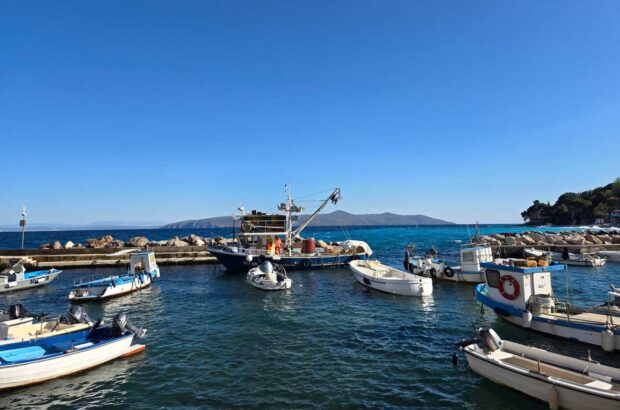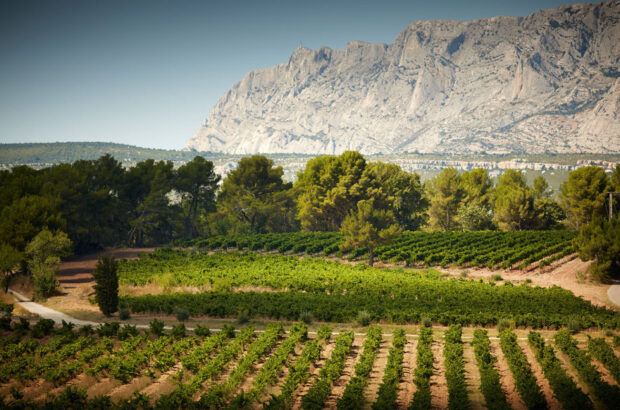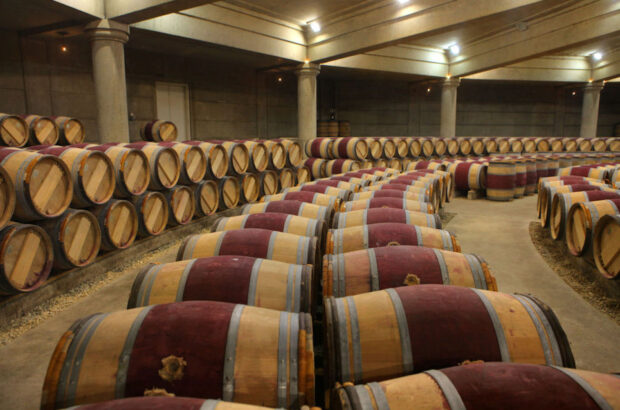Every wine culture needs an avant-garde, a revolutionary fringe or a dissident rump. Even a self-questioning, 'divinely dissatisfied' establishment will do the trick: the important thing is to keep chafing at boundaries, interrogating fundamental precepts, and dreaming of the beauty which lies just out of reach.
Swartland Vines (Image: Andrew Jefford)
The natural-wine movement is so important in Australia because of the often constrictive value placed on technical rectitude by the Australian winemaking establishment. In France, by contrast, where the lessons of limpidity and difference were learned long ago, the most useful questions tend to be asked by those at the quality apex, looking for the next quarter-per-cent of expressive grace. (Secure in the knowledge, moreover, that it will be rewarded by the market.) France’s self-appointed ‘natural’ revolutionaries, by contrast, prefer to chase demons of their own invention, mock science, and find conspiracies in common sense.
Does South Africa have the most salutary avant-garde in the southern hemisphere at present? Quite possibly. It’s lucky to have two deep thinkers leading the charge, those for whom the adjective ‘visionary’ would not be inappropriate: King Eben and Queen Rosa.
Eben Sadie is everything you would expect a quick-thinking, pure-minded, hard-surfing Calvinist to be: a winemaker, in other words, of almost alarming single-mindedness and intensity, ready to risk all in the pursuit of purity and truth to place (including wipe-outs: he claims to have poured at least seven attempts at rosé-wine making down the drain). Rosa Kruger, a great-great granddaughter of the doughty Boer leader Paul Kruger, is an open-minded former lawyer and journalist turned viticulturalist who drives up to 7,000 km a month in search of great vineyard land, either planted or unplanted, and who understands that her work is only completed by tasting, and by travelling to taste and to explore overseas. And who doesn’t consult, but ‘co-works’.
There are others, too. Adi Badenhorst likes to cast himself as the court jester (and tells very good jokes), but he’s a much better winemaker than the hapless, error-strewn incompetent he endearingly claims to be. The husband-and-wife team of Chris and Andrea Mullineux (he from Johannesburg, she from California) make a formidably effective team, and succeed in producing wines at every price point which perfectly summarise the potential of their sites, and you can’t ask more of winemakers than that.
Nobody around here is very old, but there’s already a talented ‘new’ generation of winemakers with evidently fine palates, like Chris Alheit and Donovan Rall. There are experimenters who have pushed so far at the edge that they’ve fallen right off, like (ok, this is only my opinion) the acid-obsessed, early-picking Craig Hawkins, whose Testalonga Bandito King of Grapes Grenache is (at 11.5%) fermented verjuice, and tastes like cranberry-flavoured wheat beer. And there’s an annual uprising: the Swartland Revolution, which I was lucky enough to be swept up in this year.
The great thing about the Revolution is its un-cliqueyness: the event was strewn with employee winemakers from estates of more conventional caste, drinking outside the box, as well as plenty of what looked to me like the nation’s better-heeled wine aficionados. One of the big challenges for European wine lovers visiting South Africa is that the major estates are so grand, so extensive, so beautiful, so well-endowed, so mind-blowingly opulent and so copiously staffed – the sprinklers and the lawn-mowers rarely fall silent – that it’s easy to feel a little alienated. Swartland has changed all that: it’s where the young and impecunious go to find a scrubby patch of old bush vines to love and vinify in a large milk churn. We can all relate to that.
Then, of course, there is the major premise which Swartland is predicated, articulated by Eben Sadie here, that South Africa’s low latitude means that it is essentially a Mediterranean-type growing environment, and therefore that it is Mediterranean varieties and blends, usually dry-grown as bush vines and vinified without adjustment, which will allow the terroir to speak most articulately. South Africa seems to me, in fact, to have a striking diversity of growing conditions which belie its latitudes – but the success of wines like Sadie’s own Palladius and Columella, like the Mullineux single-soil-type Syrah wines, like Adi Badenhorst’s White Blend and Red Blend, and like Chris Alheit’s complex, fine-sewn Cartology white blend (from Swartland and beyond) certainly vindicate the theory as it applies to this, South Africa’s largest delimited wine district.
The broader Revolution, though, has scarcely begun. Swartland is so large that only the long-term understanding of its component wards will bring its terroirs to full articulation. Much of it is flat – but ambitious winemaking in the upland areas of the Paardeberg, the Kasteelberg and the Porseleinberg are already furnishing striking differences. These, though, are merely the tail to the much larger upland mass of the Piketberg in Swartland’s far north. “I think,” says Rosa Kruger, “the best places are still to be planted. Up on the mountains. On top of the Piketberg, for example: why has no one planted there?”
Meanwhile, the bakkies are all heading for sandy, scruffy Skurfberg, further north still, between the small town of Clanwilliam and the Atlantic ocean, pioneered by Kruger and Sadie (for two wines in his ‘old vine’ series, the Chenin Skurfberg and the Semillon Kokerboom), and also used by Chris Alheit. Add that to what Tierhoek and Neil Ellis have done in the Piekenierskloof and what David Nieuwoudt has achieved at Cederberg – both of these areas to the far north of what was once considered the Cape’s wine heartland — and you begin to realise that South Africa now has two entirely different classes of wine-growing terroir. The first is the traditional Cape — where the fundamental heat and light of latitude is mitigated by ocean exposure and sometimes demonic winds. The second is a new, lonelier and loftier Cape wineland where those same fundamentals are mitigated by altitude. The former is akin, if you wish, to southern Victoria; the other is more like Mendoza and Salta, though neither comparison is exact. (Terroir comparisons never are.)
Without South Africa’s avant-garde, the latter might have remained unknown or ignored, its wine buried inside anonymous co-operative blends, for decades to come; and without that same avant-garde daring to leave the raw materials unadjusted in vinification, we would not finally be beginning to taste terroir rather than winemaking in South African wines from all areas. Viva!
Written by Andrew Jefford







